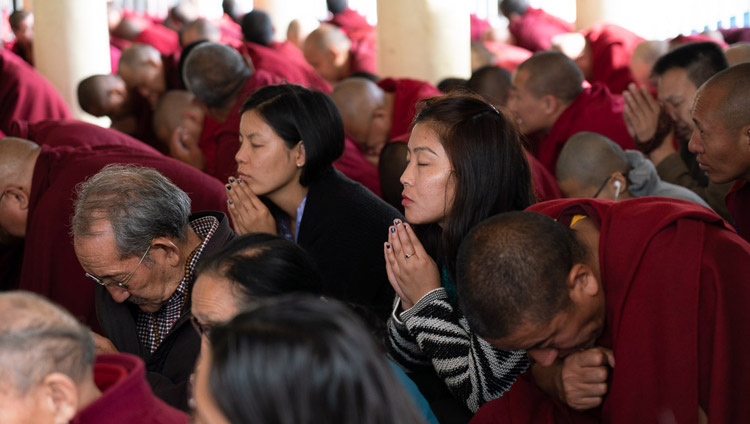
His Holiness the Dalai Lama gave a three-day teaching on the Heart Sutra in Tsuklakhan, the main temple in Dharamshala. More than 6,000 people gathered to attend the teaching, of whom more than 2,000 came from 60 different countries around the world. The teaching was mainly on the Heart Sutra but His Holiness also explained Three Principal Aspects of the Path which was composed by Jé Rinpoché in response to a letter of request from his close student Ngawang Drakpa. The teaching was by request of a group of Koreans and took place from November 4 – 6.
On the first day of the teaching, His Holinessgave an introduction to the teaching and explained the first lines of the Heart Sutra. Professor Samdhong Rinpoché conducted a review of the day’s instruction and His Holiness urged the audience to ask him as many questions as possible. On the second day of the teaching, His Holiness completed the explanation of the Heart Sutra and thengave an explanation of the Three Principal Aspects of the Path, a short teaching which has been translated into Korean.

Photo: OHHDL
His Holiness said, “Buddhism is about using reason and logic to transform our minds. Although there has been something of a custom not to study, these days I advise those interested to try to be 21st century Buddhists. This entails some level of study in order to understand what the Buddha taught.”
On the final day, he conducted a ceremony for generating the awakening mind of Bodhichitta. His Holiness said that, “Bodhichitta is the core of a bodhisattva’s practice. It brings peace of mind, which in turn brings good health.” He said that he finds it beneficial to observe this practice several times a day, and that the main aim of the Buddha’s teaching was the attainment of liberation and omniscience. His Holiness said that he prefers to refer to the Pali and Sanskrit traditionsrather than“lesser” and “greater” vehicle, and added that he likes to have Theravada monks open the teaching with their recitation because it serves as a reminder that the Pali tradition came first. He discussed the difference between the general structure of the Buddha’s teachings and specialised instructions like tantra, and then urged members of the audience to encourage their friends to be warm hearted as well. To conclude, His Holiness briefly explained that he is committed and dedicated to promoting love and compassion as a source of human happiness, encouraging inter-religious harmony and also to keeping Tibetan religion and culture – derived from the Nalanda tradition – alive. He added that he is committed to reviving Indian knowledge in modern India.





 Print
Print Email
Email